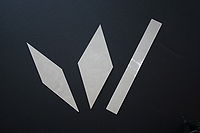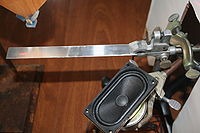Analysis of Diamond Cantilever Vibration
Purpose
In order to facilitate coherent bremsstrahlung radiation, the movement of the diamond radiator due to natural oscillation must be minimized. One possible way to mount the diamond involves supporting it from a single corner and leaving the other end free. The purpose of this work is to theoretically model the free vibrations of such a system to determine if it is a realistic solution to the problem of mounting the diamond.
Predictions
The diamond, when mounted from one corner, can be approximately modeled as a cantilever (a beam fixed at one end and free at the other) with non-uniform width. In order to determine the natural oscillatory motion of the diamond, I decided to develop a mathematical model for the motion of cantilevers with non-uniform width, and test that model with data from physical cantilevers.
Experiment
Fifteen test cantilevers of varying shapes have been cut from .032 inch thick sheet aluminum in the UConn metal-shop. (Thanks to Brendan Pratt.) Nine are of uniform width, while six have non-uniform width and are shaped like diamonds.
Step 1: Location of Resonance Frequencies Analysis was run in order to find the exact locations of the resonance frequencies for each individual cantilever. The cantilevers were mounted horizontally one at a time using a clamp to hold them fixed from one end. A microphone was set up near the tip of the cantilever, at an approximate distance of three centimeters away. The cantilever was then given a short, non-periodic impulse (a flick near the end) and allowed to settle into its natural oscillatory frequencies undisturbed. The microphone picked up the compressed air waves made by the cantilever’s vibration. This process was repeated three times for each cantilever. From this data the resonance frequencies were extracted using Fourier analysis.
Step 2: Measuring Relative Amplitude: The optical lever technique was used to determine the relative amplitude of cantilever vibration at different points along the length. Each cantilever was mounted in the same fashion as before, and the clamp was attached to a ring stand. Also attached to the ring stand was another clamp holding a small speaker. Resonance was achieved by using the speaker to produce a constant sinusoidal output, which traveled through the ring stand to excite the cantilever. A class 111a laser pointer was mounted opposite the free end of the cantilever, pointing towards the fixed end. A white projection screen was mounted above the fixed end of the cantilever. In order to amplify the motion of the cantilever, which is normally very slight, the laser is reflected off the cantilever’s surface, and its own angle of motion is augmented by that of the cantilever relative to the horizontal at the point of reflection.
To further increase this amplification, a system of mirrors was designed so that the laser would reflect off the cantilever multiple times over the same small lengthwise distance, multiplying the measured change in amplitude by the number of “bounces.” After coming out from the mirror system the laser projects onto the screen, where its sinusoidal motion reflects that of the cantilever. The motion of the laser point (keeping the number of bounces constant) was recorded at 1200 frames per second using a Casio Exilim Pro EX-F1 Digital Camera for each point along the length, moving at approximately one centimeter increments and recording the position of the center mirror relative to the cantilever base.

